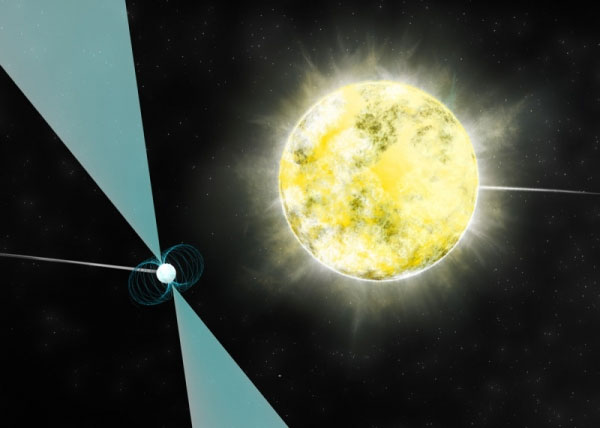Diamonds are equivalent to Earth in the universe
American astronomers have discovered a star the size of the Earth, made entirely of diamonds in the universe.
The "massive" diamond is the coldest and faintest white dwarf ever discovered. This star named PSR J2222-0137 is so cold that its carbon crystallizes, forming a diamond block of the size of our planet in the universe.
"This is really a remarkable object . The celestial bodies like it are so faint that it is difficult to observe , " said Professor David Kaplan of the University of Wisconsin-Milwaukee. Mr. Kaplan and colleagues discovered PSR J2222-0137 using the space telescopes of the US National Radio Astronomical Observatory, including the GBT telescope.

Photo simulating diamond star PSR J2222-0137 in the universe
According to experts, white dwarfs are celestial bodies created when stars of low and medium mass such as our Sun "die" (consuming the fuel of nuclear reactions in stars). These stars are not heavy enough to generate the necessary heat in the core to melt carbon in nuclear fusion reactions, after they turn into giant red stars during helium burning. At the end of this period, the outer half of the giant red star will be pushed into space to form a nebula, leaving behind an inert core containing mostly carbon and oxygen, which is the white dwarf.
White dwarfs will slowly cool and fade to such an extent that they are no longer visible over billions of years. However, with the new age of the universe at about 15 billion years, even the oldest white dwarfs still radiate at temperatures up to several thousand degrees centigrade.
The team identified that the PSR J2222-0137 dwarf is more likely than our Milky Way age, which is approximately 11 billion years old. It is located nearly 900 light-years from Earth, on the side of the constellation Aquarius.
Experts calculate that this white dwarf has a temperature of no more than 2,700 degrees Celsius. While our Sun center is about 5,000 times hotter. The discovery of a companion neutron star in the binary system helped researchers identify the white dwarf PSR J2222-0137.
- Universe: Endless diamond warehouse
- Black diamond comes from the universe, does not it?
- Can turn peanut butter into diamond
- Discover 2 diamonds larger than 100 carats in South Africa
- Learn about diamonds and how to recognize real diamonds
- Artificial diamonds cut everything in nature
- Digging the largest second-largest diamond, extremely expensive
- Russia develops counterfeit diamond solution
- Detecting diamonds in
- US made material harder than diamonds
- How to create pure diamonds like natural diamonds in 2 weeks
- Find diamonds in meteorites that fall to Earth
 Van Allen's belt and evidence that the Apollo 11 mission to the Moon was myth
Van Allen's belt and evidence that the Apollo 11 mission to the Moon was myth The levels of civilization in the universe (Kardashev scale)
The levels of civilization in the universe (Kardashev scale) Today Mars, the sun and the Earth are aligned
Today Mars, the sun and the Earth are aligned The Amazon owner announced a secret plan to build a space base for thousands of people
The Amazon owner announced a secret plan to build a space base for thousands of people